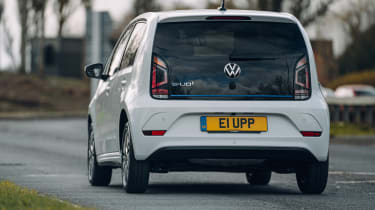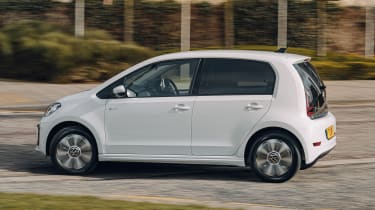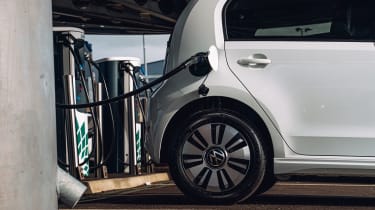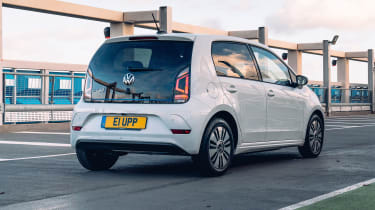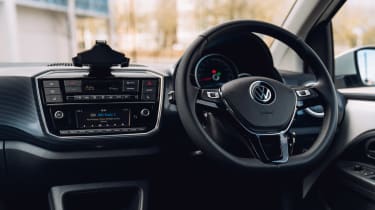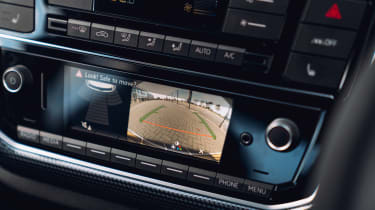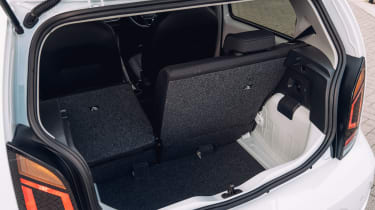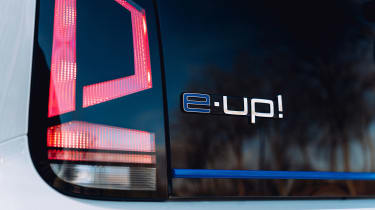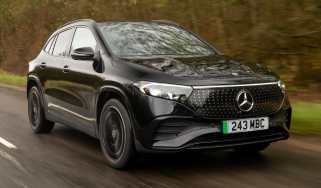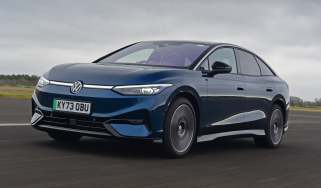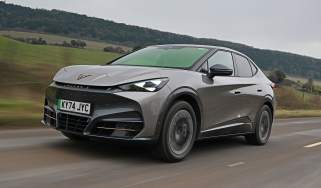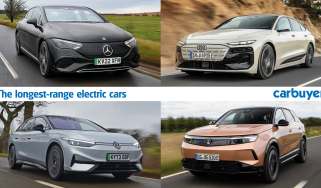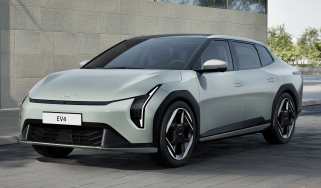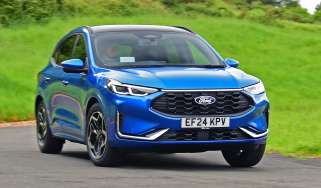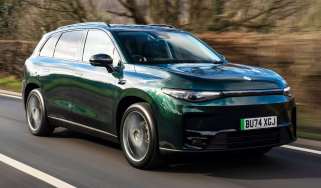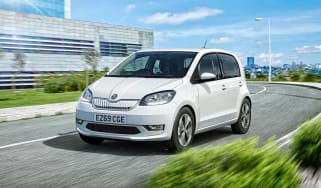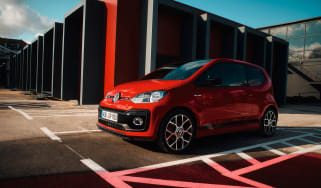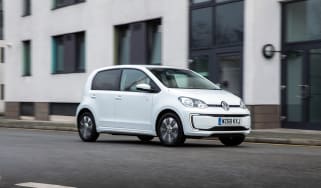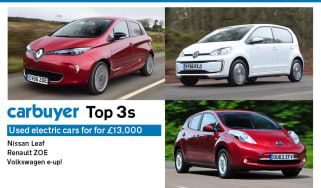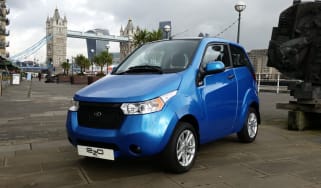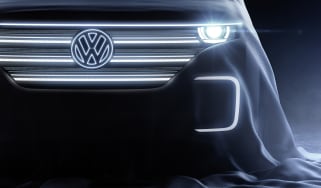Volkswagen e-up! hatchback review
“The Volkswagen e-up! is a well equipped and quick electric city car, but the price tag will put many people off”
Pros
- Quick off the lights and quiet
- Huge equipment list
- Very cheap to run
Cons
- Expensive
- Poor secondhand values
- Need a drive or garage for charging
The all-electric Volkswagen e-up! city car looks fairly similar to the petrol powered up! hatchback, with only some blue exterior trim and a set of C-shaped LED daytime running lights to set it apart. After a big update in 2019, the latest iteration of the e-up! boasts a new battery pack with nearly double the capacity of the old model, while still occupying the same amount of physical space.
In place of a petrol engine, the e-up! uses an 82bhp electric motor and a 36.8kWh battery giving it a WLTP tested range of 162 miles - a big improvement over the 99-mile range of the old car. Volkswagen say the e-up! can be topped up on the move from 0-80% taking around an hour via a 40kW CCS plug. A 7.2kW AC wallbox for home charging will be an option, giving a four hour recharge time. Charging via a standard three-pin is the slowest method, taking sixteen hours to achieve a full charge.
The e-up! is one third of a trio of cars, as it shares most of its parts with the SEAT Mii Electric and the sold-out Skoda Citigo-e iV. It also competes with Smart’s EQ ForTwo and EQ ForFour models, as well as the Renault ZOE and MINI Electric. The compact dimensions mean the e-up! feels at ease on crowded city streets.
More reviews
Business users stand to benefit from a far lower emissions-linked Benefit-in-Kind (BiK) tax bracket than would apply to a similarly priced petrol or diesel car, and this means big savings in company-car tax that may make the e-up!’s diminutive size a compromise worth making.
In the race away from the urban traffic lights, the e-up! feels rather nippier than its 11.9-second claimed 0-62mph time suggests. In other respects, the electric Volkswagen provides the same eager, alert feel behind the wheel as any other up!, and is more responsive and agile than the Renault ZOE.
The e-up! is based on the conventional up! hatchback which was last facelifted in 2017. Aside from some blue bodywork accents, aero efficient alloy wheels and the presence of an electric motor and battery pack, the e-up! looks nearly identical to its petrol powered sibling.
Inside, the e-up! is rather low-tech, with only a tiny media screen supplemented by a smartphone cradle mounted to the top of the dashboard. This allows you to use the sat nav app of your choice, or VW’s Maps & More dedicated navigation app. Overall, the interior is logically laid out with a decent amount of room in the front. The materials used in the cabin are of reasonable quality with a logical layout, although the quality does lag behind VW’s more recent models - perhaps not surprising seeing as the up! has been on sale for the best part of a decade.
That’s not to say the e-up! is sparsely equipped, as it features two-zone air con, heated front seats, a heated windscreen and a rear-view camera. It’s a lot of equipment for a city car and goes some way to offsetting the car’s chunky price.
When Euro NCAP tested the petrol powered up! in 2011 it scored a full five star safety rating. In 2019 the car was tested again, scoring only three stars as the current testing procedure now takes active safety technology into consideration. VW’s smallest model doesn’t come with features like auto emergency braking, which is at least optional in newer city cars.
If you can come to terms with that high purchase cost or are in a position to take advantage of its low tax liability, there’s definitely a place in the world for the crisply styled and fun-to-drive e-up! – especially among urban motorists who usually have a charging point close at hand.
Range, charging & running costs
Other than making a minimal contribution to urban pollution, the other big advantage of zero-emissions electric cars like the e-up! will be best appreciated by company-car users. As it produces no CO2, the e-up! occupies the lowest benefit-in-Kind (BiK) tax band.
In comparison, most economical small hatchback cars of a similar price to the e-up produce between 100 and 110g/km of CO2, which places in far higher BiK brackets above. This means that a diesel car with the same taxable (P11D) value as the e-up! may cost you more than twice as much in company-car tax.
The e-up! is expensive, even after the Government’s plug-in car grant deduction. It actually costs more than an entry-level Volkswagen Golf, and is over £3,000 dearer than the SEAT Mii Electric, which is essentially identical besides the badges.
The revised 2019 e-up!’s claimed operating range on a full charge is a claimed 162 miles miles, which will be sufficient for a majority of urban drivers and those who do shorter motorway journeys. Of course, the e-up! won’t cost you a penny in petrol, and home charging should only cost a couple of pounds. It’s also exempt from road tax and the London Congestion Charge, and the Ultra Low Emission Zone charge.
In line with other VW models, the e-up! comes with a three-year/60,000 mile warranty. Its battery pack is covered separately by a longer eight-year/99,360 mile (160,000 km) warranty. The e-up! needs to have its first service after two years or 20,000 miles, and then annually. Service plans are offered by Volkswagen retailers to help spread the cost.
Electric motor, drive & performance
Although heavy batteries mean the e-up! weighs 300kg more than the standard car, it’s nimble and fast enough that you won’t notice the extra weight. The e-up! has accurate steering and doesn’t roll too much in corners, which helps to make it far more enjoyable to drive than the Renault ZOE.
The e-up! can go from 0-62mph in 11.9 seconds, slotting between the standard car and the up! GTI. On the road, it feels even quicker than this, thanks to the way the electric motor delivers its 82bhp, and keeping up with town traffic is easy. Top speed is a claimed 81mph, but taking full advantage of this, or using full acceleration too often, may take chunks out of that claimed 162-mile range. There are two battery saving ‘Eco’ driving modes which limit performance and speed, only slightly, though, as it is still possible to reach speeds up to 75mph.
While the overall driving experience is simple and will be (save for near-silent running) familiar to up! drivers, the e-up! does feature regenerative braking, which uses the car’s slowing motion to increase battery life.
As soon as you take your foot off the accelerator, the car will lose speed, meaning you’ll rarely need to use the brakes. The system allows you to choose from five modes: D, D1, D2, D3 and B. On the last three settings, it operates the brake lights when you lift off, to warn other drivers. While this sounds relatively complicated, the system is actually simple and easy to get used to.
Interior & comfort
With the exception of a battery capacity readout in place of a fuel gauge, the e-up! is largely the same as any other up! on the inside, although there’s a notably longer list of standard equipment. As if to make amends for its price, the e-up! packs a rear-view camera, cruise control and DAB radio. You can also access information about the car remotely (such as its charging status) using a smartphone app.
Although the steering wheel only adjusts up and down, it’s still easy to get comfortable in the e-up! thanks to a supportive driver’s seat, which offers plenty of adjustability. The car is easy to drive thanks to its compact dimensions and light steering, while the suspension does a great job of smoothing out potholes and poor road surfaces.
In common with most electric cars, the e-up!’s quiet running is one of its most distinctive characteristics. The electric motor whirrs into life almost silently, while at speed the only noise you’ll hear is the car moving through the air – and the e-up! does a good job of insulating the interior from wind noise anyway.
The regenerative braking system is easy to use and adjust, and once you get used to the sensation of the car slowing automatically as soon as you lift off the accelerator, not having to brake so often actually adds to the relaxing and easy nature of the e-up!.
Practicality & boot space
The good news is that the VW e-up! doesn’t lose out on any interior or boot space compared to the rest of the range. The electric motor sits under the bonnet where the engine would usually be found and the batteries are under the rear seat, in place of the petrol tank.
The bad news is that the up! was never an especially versatile car in the first place and families are likely to find it rather tight for use as an only car - but it’s more spacious than some of its rivals. You can, at a pinch, seat a six-foot tall passenger behind a similarly tall driver, but it won’t be comfortable for long journeys. The up! is a strict four-seater, too.
The boot is actually more usable than its diminutive size might suggest. It offers the same 251-litre capacity as the up!, which is handily bigger than you’ll find in some other city cars, such as the 168-litre Toyota Aygo. And although there’s a bit of a lip that heavy loads must be lifted over, the boot floor is at least flush throughout when the rear seats are folded down. Do this and you’re met with 951 litres of total load space. While not a problem if home charging, if you need to take the two standard charging cables with you, they can fit in the space beneath the false boot floor.
Reliability & safety
Volkswagen generally has an enviable reputation for quality and reliability, although the brand would probably have liked to rank higher than 17th out of 30 manufacturers in our most recent Driver Power owner satisfaction survey.
However, delving deeply into our survey results, the comments made by owners didn’t seem quite as scathing as the scores it was punished with. In fact, despite owners rating the up! below average for reliability and build quality, only 2% of them reported one or more faults in the first year of ownership. It should be remembered, though, that the e-up! was included within the up!’s results, and owners may have enjoyed a more positive experience.
Back in 2011, the petrol version of the up! scored five-stars in its Euro NCAP safety test, but since then the rules have become more stringent. In late 2019, the e-up! was tested again and awarded a three-star safety rating. The e-up! comes with several standard safety features, such as electronic stability control, ISOFIX child-seat mounts and a seatbelt reminder. However, the e-up! lost two stars for missing out on some newer safety tech.
See how this car scored on our sister site DrivingElectric.


